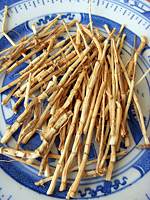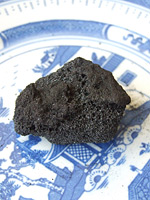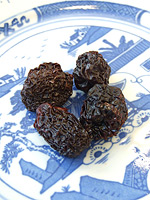Chinese Herbs for Bleeding Symptoms
- Stop bleeding: the stop bleeding herbs should be carefully selected and in proper dosage. Although the herbs can stop bleeding, they only play an auxiliary role. They should never be used on their own, and must always be combined with herbs that treat the underlying disharmonies of bleeding. The stop-bleeding herbs are selected according to their natures, such as cooling blood, warming blood, activating blood or astringent. Each herb can have more than one of these effects.
- Treating primary condition: since each of the bleeding symptom has an underlying disharmony, such as overheated blood, qi deficiency or yin deficiency, clearing the primary conditions help stop bleeding effectively. Generally, the remedies are aimed to clear heat, cool blood, replenish qi, reinforce the astringent ability of qi, nourish yin, subdue virtual fire, activate blood or remove stasis.
- Consolidating and resuming harmony: bleeding symptoms are consumptive, which exhausts blood, qi and other fundamental substances of the body, therefore after the bleeding arrested and the primary condition eliminated, individuals should have certain degree of consolidation treatment. Physicians will consider the deficient aspects of the body and select appropriate supplement herbs for tonification accordingly. For example, massive or a prolonged blood loss usually leads to a blood deficiency state, it is applicable to add extra blood-nourishing herbs such as angelica root and rehmannia root. This can enhance the efficacy of the prescription and ensure a smooth healing process.
Many Chinese herbs are available for stop bleeding. During applications, physicians will design the bleeding remedies according to disharmony patterns, bleeding sites, overall conditions of patients, and will consider the modern pharmaceutical actions of the selected herbs as well. A carefully combined herbal remedy ensures desirable clinical results.
| Bleeding characters | Therapeutic aims | Herb samples for stop bleeding |
| The blood is bright red | Cooling blood to stop bleeding | Rhizoma Imperatae (bai mao gen) Cacumen Platycladi Orientalis (ce bai ye) Herba Cirsii Japonici (da ji) Herba Cirsii (xiao ji) Radix Sanguisorbae (di yu) Flos Sophorae (huai hua) Radix Rubiae (qian cao) |
| The blood is clotty | Activating blood to stop bleeding | Radix Notoginseng (san qi) Pollen Typhae (pu huang) Nodus Nelumbinis Rhizomatis (ou jie) Radix Rubiae (qian cao) Faeces Trogopterorum (wu ling zhi) Radix Curcumae (yu jin) Crinis Carbonisatus (xue yu tan) Crotex Moutan (mu dan pi) |
| Profuse or prolonged bleeding | Astringency blood to stop bleeding | Rhizoma Bletillae (bai ji) Herba Agrimoniae (xian he cao) Petiolus Trachycarpi (zong lu tan) Os Sepiae (wu zei gu) Nodus Nelumbinis Rhizomatis (ou jie) Crinis Carbonisatus (xue yu tan) |
| The blood is thin, accompanied with limb coldness or sensitive to low temperatures | Warming blood to stop bleeding | Rhizoma Zingiberis Praeparatae (pao jiang) Folium Artemisiae Argyi (ai ye) Furnace soil (fu lung gan) |
| Bleeding accompanied with dizziness, palpitations, swallow complexion | Nourishing blood to stop bleeding | Colla Corii Asini (e jiao) Colla Cornus Cervi (lu jiao jiao) Herba ecliptae (han lian cao) Fructus Ziziphi Jujubae (da zao) |
Apart from the above category of stop-bleeding herbs, herbs from other categories are also selected for bleeding remedies. In addition, some of the stop-bleeding herbs have a tendency to work on specific body regions, reach certain organs or meridians, and thus are usually selected for specific bleeding symptoms.
| Bleeding locations | Sample herbs |
| Wound bleeding on the body surface (tropical use) | Radix Notoginseng (san qi) Rhizoma Bletillae (bai ji) Lasiosphaera Seu Calvatia (ma bo) |
| Subconjunctival bleeding |
Rhizoma Bletillae (bai ji) Herba Agrimoniae (xian he cao) Rhizoma Imperatae (bai mao gen) Nodus Nelumbinis Rhizomatis (ou jie) Cordyceps sinensis (dong chong xia cao) Radix Scutellariae Carbonisatus (huang qin tan) Cacumen Platycladi Orientalis Carbonisatus (ce bai ye tan) Herba Cirsii Japonici (da ji) Herba Cirsii (xiao ji) Pollen Typhae (pu huang) |
| Nosebleeds | Rhizoma Imperatae (bai mao gen) Herba Agrimoniae (xian he cao) Nodus Nelumbinis Rhizomatis (ou jie) Herba Cirsii (xiao ji) |
| Gum bleeding | Rhizoma Imperatae (bai mao gen) Herba Agrimoniae (xian he cao) Nodus Nelumbinis Rhizomatis (ou jie) |
| Coughing up blood | Rhizoma Bletillae (bai ji) Herba Agrimoniae (xian he cao) Rhizoma Imperatae (bai mao gen) |
| Vomiting blood | Os Sepiae (wu zei gu) Rhizoma Bletillae (bai ji) Radix Sanguisorbae (di yu) |
| Blood in the urine | Herba Cirsii Japonici (da ji) Herba Cirsii (xiao ji) Radix Sanguisorbae (di yu) Pollen Typhae (pu huang) |
| Blood in the stool | Radix Sanguisorbae (di yu) Flos Sophorae (huai hua) Radix Notoginseng (san qi) Furnace soil (fu lung gan) |
| Bleeding under the skin | Peanut skin Fructus Ziziphi Jujubae (da zao) Charred lotus leaf |
| Uterine bleeding | Herba Agrimoniae (xian he cao) Radix Rubiae (qian cao) Pollen Typhae (pu huang) Folium Artemisiae Argyi (ai ye) |
 couch grass rhizome |
 carbonized hair |
 Chinese date |
Generally, no matter what medical conditions that caused abnormal bleeding, TCM treatments often aim at clearing fire/heat evils, improving qi (vital energy) and blood conditions, and a harmonized blood is the ultimate goal of all. Physicians have to follow the above general principles when designing the herbal prescriptions.


